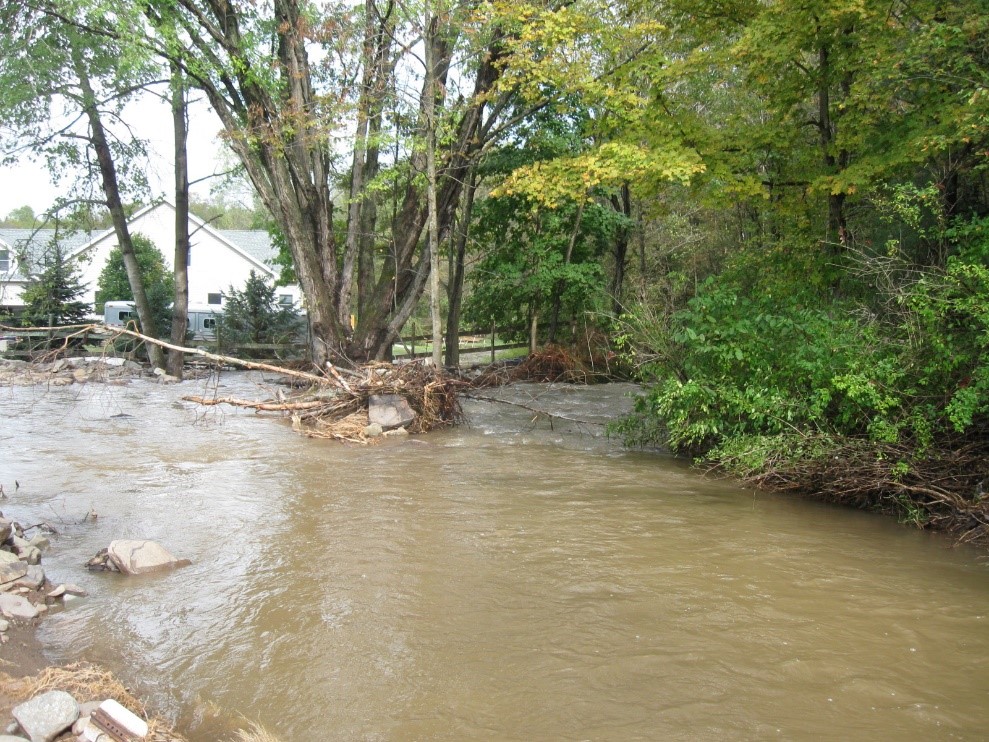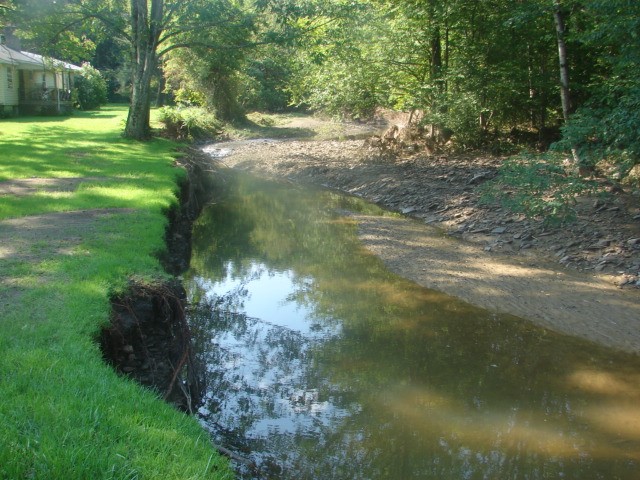Advice on Flood Prevention and Management on Streams
Pennsylvania’s Geography and Meteorology
Pennsylvania has 86,000 miles of streams and rivers, second only to Alaska. Statewide average rainfall is 42 inches per year, partially due to its mountainous terrain. These factors combine to create the potential for flooding nearly anywhere in the state, any time of year. Two storms in September 2011 dropped an unprecedented amount of rain on the state. In more recent years, localized storms affecting portions of counties or 1 or two counties is regularly resulting in flooding and storm events exceeding the 1% chance (A.k.a. 100-year storm event). With climate change, increasing storm intensities and flooding is expected and planning for these storms and flooding is important for the management of our water resources and our water obstructions and encroachments.

Flood Recovery
Following a flood, the removal of flood debris such as trees, logs, brush, rubbish, or similar material (but not gravels and sediments) from a stream channel does not need a permit or pre-approval from the Department of Environmental Protection (DEP) as long as the work is accomplished from the stream bank. Owners of permitted bridges and culverts do not need DEP’s authorization to clean debris provided it is performed in accordance with the permit conditions and
Standards for Channel Cleaning at Bridges and Culverts. It is recommended that bridge and culvert owners use DEP’s
online Bridge & Culvert Maintenance & Repair Tool.
Accordion
Expand AllClick here for a more accessible versionLocal governments are reminded to document their costs for the removal or repair of water obstructions and encroachments that have been damaged or lost due to flooding and debris removal for later possible reimbursement by the federal government. Pictures of debris, equipment and labor costs can be kept to document removal costs. Be sure to take pictures of the damage before any work has begun. Questions about documentation should be directed to county emergency management officials and the Pennsylvania Emergency Management Agency (PEMA).
Stream Restoration vs. Maintenance Dredging
DEP promotes stream restoration projects in lieu of stream dredging activities. A common misconception is that removing recently deposited gravel from a stream channel creates additional capacity for water to flow during storm or flooding events. However, sediment and gravels are typically mobilized in larger storm events and will redeposit as flows decrease. Another common misconception is that dredging a channel or stream deeper and wider than it was prior to the last flooding event will create even more capacity for water to flow during storm or flooding events. However, this can cause additional and excessive gravel and sediment deposits after a storm, increase flooding on adjacent properties, or have other adverse effects to the environment or property. Poorly devised, randomly executed or unevaluated dredging, deepening or widening of streams has proven to be ineffective in preventing subsequent flooding. In summary, all streams transport sediment during storm events and dredging, deepening or widening of streams reduces the stream’s capacity to effectively transport normal sediment loads. This leads to rapid sediment deposition in the channel, as well as channel instability, increased stream bank erosion and damage to aquatic environments.
However, DEP also recognizes that Pennsylvania’s streams have many alterations such as bridges and culverts, channel alignment and depth alterations, and other historic factors which can (in current conditions) alter the streams flooding dynamics, energy dissipation, and sediment transport. DEP also understands that our historic alterations and man-made structures and infrastructure may be threatened by deposits after large storm events. Therefore, if you are concerned about large storm event deposits threatening property, structures, or the environment,
contact DEP to discuss what options may be available to you to mitigate such threats.

When is a Permit Needed?
Depending on the scope of the project, applicants may need to apply for a general permit for gravel removal (GP-3), other General Permit, or a Chapter 105 Dam Safety and Waterway Management permit. Carefully planned and appropriately engineered stream restoration projects can improve a stream channel’s ability to transport sediment and maintain its natural capacity. This should improve a stream’s performance during a flooding event and maintain existing aquatic environments.
DEP can also issue emergency permits for recovery work. As an example, during the storms of September 2011, DEP issued 330 emergency permits for work on streams, bridges, culverts, and other infrastructure. Work performed under these permits included bank stabilization and removal of accumulated silt and sediment from stream channels. Debris removed from streams, which included wood, propane tanks, portions of manufactured homes and trailers, among other things, piled up against bridge piers and trees.
Flood Protection Program
Pennsylvania has one of the most extensive
flood protection programs in the nation. DEP plans, designs, constructs and inspects flood control projects that are designed to provide protection for a 100-year flood. DEP responds to requests from flood-prone communities by determining the work needed to address each community’s problems. More information is available at
DEP’s Flood Protection Program webpages.